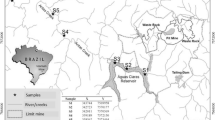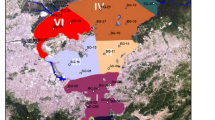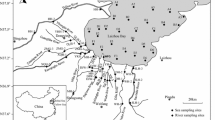Abstract
Sulfide formation in anaerobic lake sediments depends on supply rates of organic carbon and sulfate. Improvements to wastewater treatment plant effluent quality (e.g., lower total phosphorus (P)) and sulfur emissions can affect sulfide formation rates, which, in turn, can affect metal chemistry including internal iron loading. To determine if these improvements corresponded with sulfide and iron-related signals in sediments over time, acid-volatile sulfide (AVS) and acid-extractable iron accumulation rates were measured in sediment cores of two lakes with anaerobic hypolimnia, the formerly eutrophic, now mesotrophic central basin of Lake Erie, one of the Laurentian Great Lakes, and a small meso-eutrophic moraine lake in southern Ontario, Lake St. George. AVS accumulation rates declined gradually in both lakes after 1980 by 95% and 57%, respectively. Acid-extractable iron accumulation rate profiles were similar to AVS in both lakes, but acid-extractable iron rates were several orders of magnitude larger than AVS rates, hence most of the iron was not chemically associated with AVS. In contrast to the gradual declines in AVS, total P loading to Lake Erie did not decline much after 1980, total P concentrations in Lake St. George remained relatively constant between 1980 and 2014, and sulfate concentration decreases were too small in both lakes to account for the large AVS declines after 1980. Hence, productivity and sulfur emission signals appear to have been overridden by diagenetic processes, which produced similar profiles. Therefore, AVS and acid-extractable iron do not appear to be useful as paleo-indicators of trophic status and sulfate deposition.








Similar content being viewed by others
References
Aas W, Mortier A, Bowersox V, Cherian R, Faluvegi G, Fagerli H, Hand J, Klimont Z, Galy-Lacaux C, Lehmann CMB, Lund Myhre C, Myhre G, Olivié D, Sato K, Quaas J, Rao PSP, Schulz M, Shindell D, Skeie RB, Stein A, Takemura T, Tsyro S, Vet R, Xu X (2019) Global and regional trends of atmospheric sulfur. Sci Rep 9:953. https://doi.org/10.1038/s41598-018-37304-0
Appleby PG, Oldfield F (1978) The calculation of 210Pb dates assuming a constant rate of supply of unsupported 210Pb to the sediment. CATENA 5:1–8
Appleby PG, Oldfield F (1983) The assessment of 210Pb data from sites with varying sediment accumulation rates. Hydrobiologia 103:29–35
Azcue JM, Rosa F, Mudroch A (1996) Distribution of major and minor elements in sediments and pore water of Lake Erie. J Great Lakes Res 22:389–402
Baustian MM, Brooks YM, Baskaran M, Leavitt PR, Liu B, Ostrom N, Stevenson RJ, Rose JB (2020) Paleo-environmental evidence of ecosystem change in Lake St. Clair region of Laurentian Great Lakes basin: contrasting responses to land-use change and invasive mussels. J Paleolimnol 63:177–193
Bédard C, Knowles R (1997) Some properties of methane oxidation in a thermally stratified lake. Can J Fish Aquat Sci 54:1639–1645
Bertram PE (1992) Total phosphorus and dissolved oxygen trends in the central basin of Lake Erie, 1970–1991. J Great Lakes Res 19:224–236
Brouwer H, Murphy TP (1994) Diffusion method for the determination of acid-volatile sulfides (AVS) in sediment. Environ Toxicol Chem 13:1273–1275
Canavan RW, van Cappelen P, Zwolsman JJG, van den Berg GA, Slomp CP (2007) Geochemistry of trace metals in a fresh water sediment: field results and diagenetic modeling. Sci Tot Environ 381:263–279
Carignan R, Tessier A (1988) The co-diagenesis of sulfur and iron in acid lake sediments of southwestern Québec. Geochim Cosmochim Acta 52:1179–1188
Chapra SC, Dove A, Warren GJ (2012) Long-term trends of Great Lakes major ion chemistry. J Great Lakes Res 38:550–560
Compeau GC, Bartha R (1985) Sulfate-reducing bacteria: principal methylators of mercury in anoxic estuarine sediment. Appl Environ Microbiol 50:498–502
Couture R-M, Fischer R, van Cappellen P, Gobeil C (2016) Non-steady state diagenesis of organic and inorganic sulfur in lake sediments. Geochim Cosmochim Acta 194:15–33
Crusius J, Anderson RF (1991) Core compression and surficial sediment loss of lake sediments of high porosity caused by gravity coring. Limnol Oceanogr 36:1021–1031
Dolan DM (1993) Point source loadings of phosphorus to Lake Erie: 1986–1990. J Great Lakes Res 19:212–223
Dove A, Chapra SC (2015) Long-term trends of nutrients and trophic response variables for the Great Lakes. Limnol Oceanog 60:696–721
Eimers CM, Dillon PJ, Watmaugh SA (2004) Long-term (18-year) changes in sulphate concentrations in two Ontario headwater lakes and their inflows in response to decreasing deposition and climate variations. Hydrol Process 18:2617–2630
Evans JC, Prepas EE (1997) Relative importance of iron and molybdenum in restricting phytoplankton biomass in high phosphorus saline lakes. Limnol Oceanogr 42:461–472
Feng J, Vet R, Cole A, Zhang L, Cheng I, O’Brien J, Macdonald A-M (2021) Inorganic chemical components in precipitation in the eastern US and Eastern Canada during 1989–2016: temporal and regional trends of wet concentration and wet deposition from the NADP and CAPMoN measurements. Atmos Environ. https://doi.org/10.1016/j.atmosenv.2021.118367
Gleyzes C, Tellier S, Astruc M (2002) Fractionation studies of trace elements in contaminated soils and sediments: a review of sequential extraction procedures. Trends Anal Chem 21:451–467
Government of Ontario (2021) Acid deposition. Indicator trends available from https://www.ontario.ca/page/acid-deposition
He J, Lu C, Fan Q, Xue H, Bao J (2011) Distribution of AVS-SEM, transformation mechanism and risk assessment of heavy metals in the Nanhai Lake in China. Environ Earth Sci 64:2025–2037
Holmer M, Storkholm P (2001) Sulphate reduction and sulphur cycling in lake sediments: a review. Fresh Wat Biol 46:431–451
Howard DE, Evans RD (1993) Acid-volatile sulfide (AVS) in a seasonally anoxic mesotrophic lake: seasonal and spatial changes in sediment AVS. Environ Toxicol Chem 12:1051–1057. https://doi.org/10.1002/etc.5620120611
Jeppesen E, Sondergaard M, Jensen J, Havens K, Anneville O, Carvalho L, Coveney M, Deneke R, Dokulil M, Foy B, Gerdeaux D, Hampton S, Hilt S, Kangur K, Kohler J, Lammens E, Lauridsen T, Manca M, Miracle M, Moss B, Noges P, Persson G, Phillips G, Portielje R, Schelske C, Straile D, Tatrai I, Willen E, Winder M (2005) Lake responses to reduced nutrient loading—an analysis of contemporary long-term data from 35 case studies. Freshwat Biol 50:1747–1771. https://doi.org/10.1111/j.1365-2427.2005.01415.x
Jia J, Yang Y, Cai T, Gao J, Xa X, Li Y, Gao S (2008) On the sediment age estimated by 210Pb dating: probably misleading “prolonging” and multiple-factor-caused “loss.” Acta Oceanol Sin 37:30–39. https://doi.org/10.1007/s13131-018-1214-4
Kemp ALW, Anderson TW, Thomas RL, Mudrochova A (1974) Sedimentation rates and recent sediment history of Lakes Ontario, Erie and Huron. J Sediment Petrol 44:207–218
Kemp ALW, MacInnis GA, Harper NS (1977) Sedimentation rates and a revised sediment budget for Lake Erie. J Great Lakes Res 3:221–233
Klerks PL, Fraleigh PC, Lawniczak JE (1996) Effects of zebra mussel (Dreissena polymorpha) on seston levels and sediment deposition in western Lake Erie. Can J Fish Aquat Sci 53:2284–2291
Lafontaine N, McQueen DJ (1990) Contrasting trophic level interactions in Lake St. George and Haynes Lake (Ontario, Canada). Can J Fish Aquat Sci 48:356–363
Leonard EN, Mattson VR, Benoit DA, Hoke RA, Ankley GT (1993) Seasonal variation of acid volatile sulfide concentration in sediment cores from three northeastern Minnesota lakes. Hydrobiologia 271:87–95
Lesven L, Gaob Y, Billona G, Leermakersb M, Ouddanea B, Fischera J-C, Baeyensb W (2008) Early diagenetic processes aspects controlling the mobility of dissolved trace metals in three riverine sediment columns. Sci Tot Environ 407:447–459
Lukkari K, Hartikainen H, Leivuori M (2007) Fractionation of sediment phosphorus revisited. I: fractionation steps and their biogeochemical basis. Limnol Oceanogr Methods 5:433–444
Maccoux MJ, Dove A, Backus SM, Dolan DM (2016) Total and soluble reactive phosphorus loadings to Lake Erie. A detailed accounting by year, basin, country, and tributary. J Great Lakes Res 42:1151–1165
McQueen DJ, Lean DRS (1987) Influence of water temperature and nitrogen to phosphorus ratios on the dominance of blue–green algae in Lake St. George. Ontario Can J Fish Aquat Sci 44:598–604
McQueen DJ, Mills EL, Forney JL, Johannes MRS, Post JR (1992) Trophic level relationships in pelagic food webs: comparisons derived from long-term data sets for Oneida lake, New York (USA) and Lake St. George, Ontario (Canada). Can J Fish Aquat Sci 49:1588–1596
Molot LA, Miller SA, Dillon PJ, Trick CG (2003) A simple method for assaying extracellular hydroxyl radical activity and its application to natural and synthetic waters. Can J Fish Aquat Sci 60:203–213
Morse JW, Luther GW III (1999) Chemical influences on trace metal-sulfide interactions in anoxic sediments. Geochim Cosmochim Acta 63:3373–3378
Morse JW, Millero FJ, Cornwell JC, Rickard D (1987) The chemistry of the hydrogen sulfide and iron sulfide systems in natural waters. Earth Sci Rev 24:1–42
Murray TE (1995) The correlation between iron sulfide precipitation and hypolimnetic phosphorus accumulation during one summer in a softwater lake. Can J Fish Aquat Sci 52:1190–1194
Naylor C, Davison W, Motelica-Heino M, van Den Berg GA, van Der Heijdt LM (2006) Potential kinetic availability of metals in sulphidic freshwater sediments. Sci Tot Environ 357:208–220
Norton SA, Coolidge K, Amirbahman A, Bouchard R, Kopáčeke J, Reinhardt R (2008) Fractionation of sediment phosphorus revisited. I: fractionation steps and their biogeochemical basis. Limnol Oceanogr Methods 5:433–444
Nriagu J, Kemp ALW, Wong HKT, Harper N (1979) Sedimentary record of heavy metal pollution in Lake Erie. Geochim Cosmochim Acta 43:247–258
Nriagu J (1975) Sulphur isotopic variations in relation to sulphur pollution of Lake Erie. In: Symposium on isotope ratios as pollutant source and behaviour indicators. International Atomic Energy Agency, Vienna, Austria, 18–22 November 1974, Proceedings Series, pp 77–93
Nürnberg GK (1995) Quantifying anoxia in lakes. Limnol Oceanogr 40:1100–1111
Psenner R, Pucsko R (1988) Phosphorus fractionation: advantages and limits of the method for the study of sediment P origins and interactions. Arch Hydrobiol Beih Ergebn 30:43–59
Rickard D, Morse JW (2005) Acid volatile sulfide (AVS). Mar Chem 97:141–197
Ritson PI, Esser BK, Niemeyer S, Flegal AR (1994) Lead isotopic dissemination of historical sources of lead to Lake Erie, North America. Geochim Cosmochim Acta 58:3297–3305
Scavia D, Allan JD, Arend KK, Bartell S, Beletsky D, Bosch NS, Brandt SB, Briland RD, Daloğlu I, DePinto JV, Dolan DM (2014) Assessing and addressing the re-eutrophication of Lake Erie: central basin hypoxia. J Great Lakes Res 40:226–246
Schindler DW (2012) The dilemma of controlling cultural eutrophication. Proc R Soc B 279:4322–4333
Smith SJ, van Aardenne J, Klimont Z, Andres RJ, Volke A, Delgado Arias S (2011) Anthropogenic sulfur dioxide emissions: 1850–2005. Atmos Chem Phys 11:1101–1116
Environment and Climate Change Canada and the U.S. Environmental Protection Agency (2021) State of the Great Lakes 2019 Technical Report. Cat No. En161-3/1E-PDF. EPA 905-R-20-044. Available at binational.net
Thiel J, Byrne JM, Kappler A, Schink B, Pester M (2019) Pyrite formation from FeS and H2S is mediated through microbial redox activity. Proc Nat Acad Sci 116:6897–6902. https://doi.org/10.1073/pnas.1814412116
Turner LJ, Delorme LD (1996) Assessment of 210Pb data from Canadian lakes using the CIC and CRS models. Environ Geol 28:78–87
van den Berg GA, Buykx SEJ, van den Hoop MAGT, van der Heidjt LM, Zwolsman JJG (2001) Vertical profiles od trace metals and acid-volatile sulphide in a dynamic sedimentary environment: Lake Ketel, The Netherlands. Appl Geochem 16:781–791
van Griethuysen C, de Lange HJ, van den Heuij M, de Bies SC, Gillissen F, Koelmans AA (2006) Temporal dynamics of AVS and SEM in sediment of shallow freshwater floodplain lakes. Appl Geochem 21:632–642
Yuan F (2017) A multi-element sediment record of hydrological and environmental changes from Lake Erie since 1800. J Paleolimnol 58:23–42
Zhou Y, Michalak AM, Beletsky D, Rao YR, Richards RP (2015) Record-breaking Lake Erie hypoxia during 2012 drought. Environ Sci Technol 49:800–807
Acknowledgements
This work was funded by Natural Sciences and Engineering Council Canada. We thank Rick Bourbonniere for his constructive advice and are grateful to Environment Canada and Climate Change and the crew of the CCGS Limnos for their technical support.
Author information
Authors and Affiliations
Corresponding author
Additional information
Publisher's Note
Springer Nature remains neutral with regard to jurisdictional claims in published maps and institutional affiliations.
Rights and permissions
About this article
Cite this article
Verschoor, M.J., Molot, L.A. & Zastepa, A. Acid-volatile sulfide and acid-extractable iron sediment profiles do not track changes in lake trophic status and atmospheric sulfur deposition. J Paleolimnol 68, 189–201 (2022). https://doi.org/10.1007/s10933-022-00240-1
Received:
Accepted:
Published:
Issue Date:
DOI: https://doi.org/10.1007/s10933-022-00240-1




